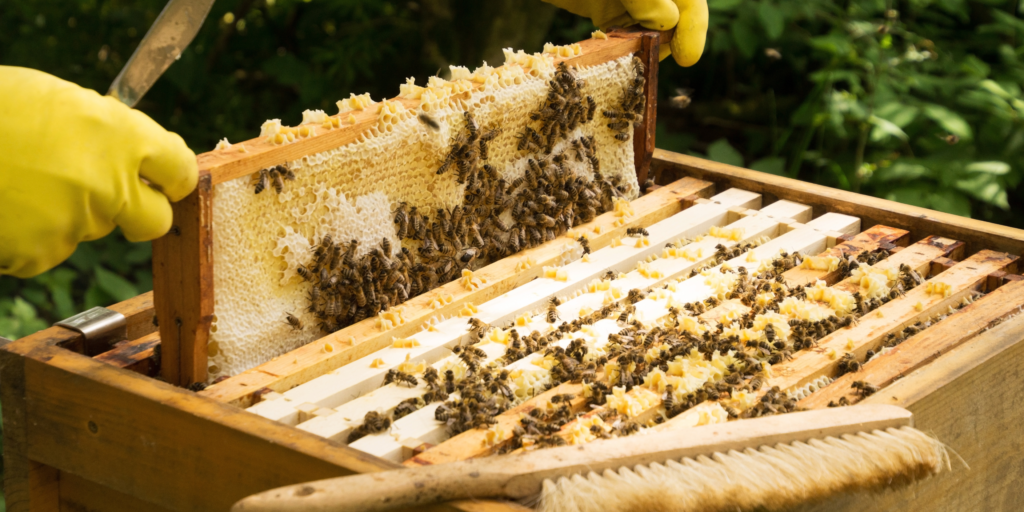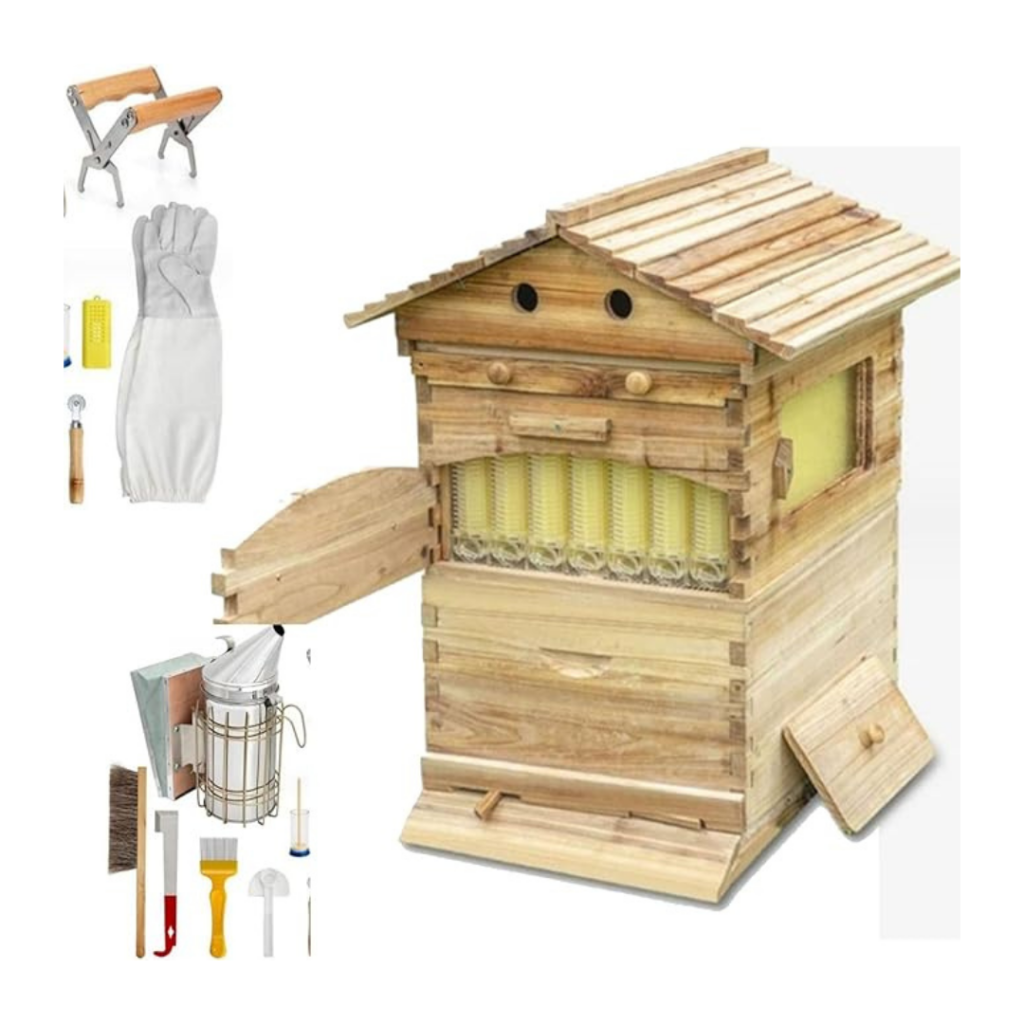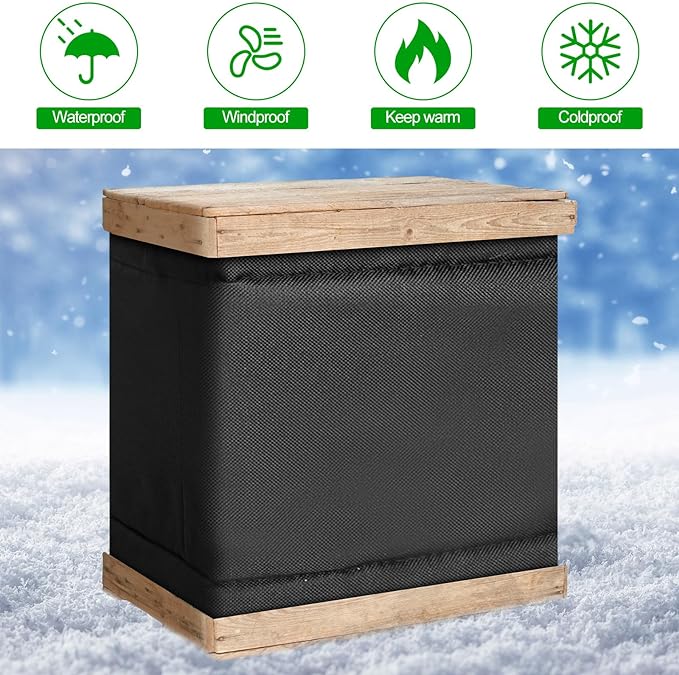Welcome to the fascinating world of beekeeping, an ancient practice that has brought healing and abundance from our planet’s most vital pollinators. Bees are not just creators of honey; they are crucial in maintaining the balance of our ecosystems. In this blog, you will learn all about the essentials of beekeeping, from understanding the rich history of apiculture to the practical steps of starting your first hive.
Apiculture History
The first evidence of honey collection comes from Spain and dates back to at least 15,000 years ago. These honey collectors were not beekeepers but would collect honey from wild hives. It wasn’t until 10,000 years later, in ancient Egypt, that organized beekeeping was first recorded.
For thousands of years, honey bee colonies were kept in wooden boxes, straw skeps, pottery vessels and other containers. In 1852, a Congregational minister from Pennsylvania named L.L. Langstroth, patented a hive with movable frames that are still used today. Soon after his invention, other designs followed that made large-scale, commercial bee-keeping possible.

Beginner Beekeeping Guides
Embarking on the journey of beekeeping can be both exciting and overwhelming for beginners. With so much to learn, it’s crucial to start with thorough and reliable guides that can offer both credible knowledge and practical advice. In this section, we’ll explore what makes a good beginner’s guide, the essential topics it should cover, and where to find the best resources.
Understanding the Basics
A good beginner beekeeping guide should start with the fundamentals. This includes understanding bee biology, behavior, and the various types of bees. It’s important to learn about the lifecycle of bees, their role in the ecosystem, and why they’re essential for pollination.
Choosing the Right Guide
When selecting a guide, look for resources that are well-reviewed and recommended by experienced beekeepers. Books such as “The Beekeeper’s Handbook” by Diana Sammataro and Alphonse Avitabile, or “Beekeeping for Dummies” by Howland Blackiston, are great starting points. These books offer detailed insights into beekeeping basics, equipment, and hive management.
Joining a Community
Connecting with local beekeeping clubs or associations can be immensely beneficial for beginner beekeepers. These communities offer a wealth of knowledge and resources, including beginner guides, workshops, and the opportunity to learn from experienced beekeepers. Additionally, they can provide advice specific to your area of beekeeping, which is particularly important as beekeeping can vary greatly depending on your climate and environment. By joining a local beekeeping community, you’ll have access to a network of like-minded individuals who are passionate about beekeeping and can offer valuable insights and support to help you succeed in your journey as a beekeeper.
Practical Tips and Troubleshooting
A comprehensive guide should not only teach you how to start and maintain your hive but also how to troubleshoot common problems. Topics like managing pests and diseases, understanding bee behavior during different seasons, and how to safely inspect and handle your hive are crucial.
Sustainability and Ethical Practices
Modern beekeeping also involves understanding the ethics and sustainability of beekeeping. Guides should cover how to keep bees healthy and happy, focusing on organic, bee-friendly practices.
Starter Kits and Beginner Bee Hives
When venturing into the world of beekeeping, having the right starter kit and equipment is crucial for both the health of your bees and your success as a beekeeper. Starter kits and beginner bee hives are designed to provide you with the essentials, making the process of starting your beekeeping journey much smoother. Here, we’ll discuss what these kits typically include, the components of a beginner bee hive, and offer advice on selecting quality equipment.
What Do Beekeeping Starter Kits Typically Include?
A seekeeping starter kit should include essential tools like a smoker, protective gear and tools. A high-quality starter kit, like the HASWEX Automatic Flow Beehive Starter Kit, includes not just the hive itself but also a range of beekeeping tools. This particular kit is perfect for beginners and professional beekeeper, providing durability and ease of use.
Components of a Beginner Bee Hive
A beginner beehive should include a quality bee hive made of high-quality materials so that your bees are happy and healthy. It should also include essential tools like protective gear, a bee smoker and hive tools. If you’re handy, you can build your own as well!
Features and Materials
The HASWEX beekeeper starter kit stands out for its durability and resistance to harsh conditions. The cedar wood and beeswax coating ensure that the hive remains dry, corrosion-resistant, and robust enough to withstand outdoor elements.
Additional Equipment
The HASWEX kit comes equipped with a 12-piece beekeeping set, which includes items like a smoker, hive tools, and protective gear. This ensures that you have everything you need to manage and care for your bees effectively. Not only is this kit ideal for beginners, but it also serves as a thoughtful gift for experienced beekeepers looking to expand their apiary.
Adding a Honey Extractor
For those looking to take their beekeeping to the next level, consider the VEVOR Electric Honey Extractor. This extractor, suitable for both small and medium-scale beekeepers, features a 4/8 frame capacity and is made of stainless steel. Its transparent lid allows for easy monitoring of the honey extraction process, and the height-adjustable stand adds convenience and flexibility. This extractor is an excellent investment for those looking to harvest honey from their hives efficiently.
Purchasing Quality Equipment
When purchasing beekeeping equipment, it’s important to buy from reputable sellers. Look for suppliers who specialize in beekeeping supplies, as they can offer quality products and knowledgeable advice. Online platforms can also be a good source, but make sure to read reviews and check the seller’s credibility.
When to Start a Bee Hive
Starting a bee hive at the right time of the year can significantly impact the health and productivity of your bees. Understanding the best times to start while considering your local climate is essential.
Best Times of the Year to Start
The best time to start a bee hive is in the spring. This season provides bees with abundant flowering plants to collect nectar and pollen, which is essential for building a solid and healthy colony. Starting in spring also allows the colony to grow and strengthen throughout the summer, preparing them for the winter months to come.
Climate and Local Environment Factors
Your local climate will also determine the best time to start your hive. In regions with milder winters, you might be able to start a little earlier or later than the typical spring window. In areas with harsh winters, it’s crucial to establish your hive early enough in spring so that the colony has enough time to prepare for the cold season. It is also important to consider local flowering patterns, as bees rely heavily on local flora for nutrition.
Preparing Beehives for the Winter
With cold winter weather upon us, preparing your beehives will ensure your bees survive the winter. Most bee populations are in tune with the climate and know when to gather and store nectar and pollen to have plenty in reserves. The winter season is a harsh time for most of nature, but with the right winterizing supplies, your bees can make it through to springtime.
Beehive insulation wraps can keep your hive warm and comfortable during the cold months by blocking wind, snow, and rain, enabling bees to withstand the harsh winter weather. Insulated wraps for bee hives are easy to use, save energy, and are reusable for future winters.
Preparations Before Receiving Bees
Before your bees arrive, ensure your hive is fully assembled and located in a suitable area. The site should be protected from strong winds, have good sun exposure, and be away from high-traffic areas. Have all your beekeeping gear ready, including protective clothing, a smoker, and hive tools. It’s also wise to read up on bee behavior and hive management so you’re prepared for the arrival of your bees.
How Difficult is Beekeeping?
Beekeeping, like any worthwhile endeavor, comes with its unique set of challenges and rewards. The journey requires time, effort, and resources, but the pride and benefits it brings can be immensely fulfilling.
Challenges in Beekeeping
One of the primary challenges in beekeeping is the time and effort required to maintain healthy hives. Regular hive inspections, managing pests and diseases, and harvesting honey are all necessary aspects of beekeeping that demand attention and dedication. Additionally, understanding bee behavior and responding to their needs through different seasons requires patience and a willingness to learn.
Rewards of Beekeeping
Despite these challenges, the rewards of beekeeping are abundant. Immense joy comes when harvesting your own honey, but more than that, beekeeping offers a deep connection to nature. It’s a peaceful, meditative activity that can provide a profound sense of accomplishment. As a beekeeper, you are critical in supporting local ecosystems and biodiversity.
Encouragement for Beginners
For those new to beekeeping, it’s important to approach this hobby with patience and an eagerness to learn. Remember, every experienced beekeeper once started as a beginner, and mistakes are part of the learning process. There are numerous resources, communities, and fellow beekeepers who can offer guidance and support. Embrace the journey, enjoy the learning experience, and take pride in your contributions to the environment and bee populations.
Note: As an Amazon Associate, I earn from qualifying purchases made through links in this post.






